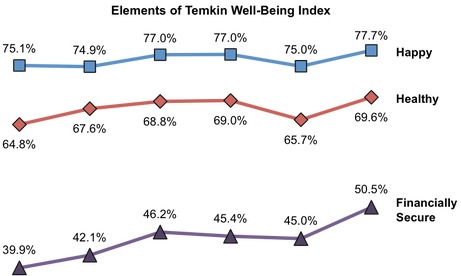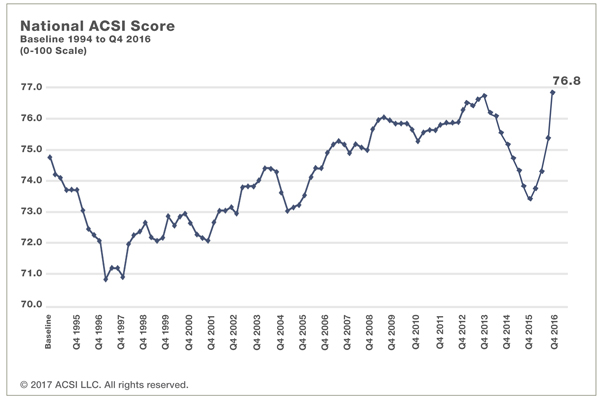
Imagine your CX program has been moving along at a satisfactory pace for months. Your CX metrics are reliable–some peaks, some valleys–but nothing too concerning. Then something shifts. It may be sudden or gradual–but you recognize that your CX survey scores are in decline.
What should you do when this happens? Taking four clear actions can help organizations discern the causes of declining metrics–and clarify steps to revive falling CX survey scores.
1. Look at the Big Picture
Do falling CX survey scores mean your organization has done something wrong? Not necessarily, according to CX thought leader Bruce Temkin.
Each year, his CX research and consulting firm, The Temkin Group completes a thorough consumer study, called the Temkin Well-Being Index (TWI), which it has analyzed since 2012 and published since 2014. TWI measures how many U.S. adults agree with the following three statements:
- I am typically happy
- I am healthy
- I am financially secure

Image Source: Temkin Group
A clear decline across any of these dimensions can cause the overall TWI score to decrease. And if consumers’ well-being is dropping, their perceptions and ratings of brands may fall as well. This can send CX survey scores into decline–even if a company is doing all the right things to advance their CX program.
That means a declining score may not be unique to your company–but part of a widespread trend of general consumer malaise. For additional insight on the consumer climate, you can also look to other trusted research sources, such as:
- Gallup: regular opinion research published on topics such as employee engagement, economic confidence, and consumer spending that can provide insights on overall consumer perceptions.
- American Customer Satisfaction Index (ACSI): consumer satisfaction measured across multiple industries to provide important customer experience insights. ASCI also provides a quarterly overall U.S. customer satisfaction rating:

Image Source: American Customer Satisfaction Index
You may find that a decrease in your CX survey scores is in line with general declines in customer attitudes. If so, you can trust that your CX efforts haven’t gone completely awry.
Still, that doesn’t mean you shouldn’t work to improve your CX program. In fact, Bruce Temkin recommends looking for opportunities to push your CX program to new levels of excellence when CX scores are low:
But with consumers comparing your company to the best companies across all industries, you probably need to set your CX sights a bit higher. Keeping up with mediocre peers is a losing strategy.
As the gap between customer expectations and existing CX grows, there will be more opportunities to improve CX and expand your business. But only some companies will be able to take advantage of this growing CX thirst; others will see an exodus of increasingly disappointed customers. Choose your path.
2. Understand Common Causes of Customer Dissatisfaction
Studying general consumer attitudes or trends within your industry may provide context for falling CX survey scores. You should also understand common things that companies do that cause significant frustration–and assess whether your organization is guilty of these missteps.
According to research by consulting firm Accenture, there are six top causes of customer unhappiness and churn:
- Making multiple contacts to a company to address the same issue (91%)
- Being on hold for long periods (90%)
- Repeating concerns or questions to multiple representatives (89%)
- Feeling that a company makes it difficult to do business with them (85%)
- Discerning differences between a company’s marketing promises and the experiences they deliver (84%)
- Having inconsistent experiences across several channels (58%)
What’s the takeaway? Even when you company is working hard to build a best-in-class CX program, you’ll only see success when you apply the insights you gain to improve customer experiences.
Avoid common CX mistakes–and the ones revealed through the CX feedback you gather–to keep your CX survey scores on the upswing.
3. Clarify Any Potential Root Causes of Falling CX Survey Scores
Sometimes strategic business actions or process changes can cause a dip in CX survey scores. You may be able to predict some of these score variations, while others’ may be beyond your control.
For example, if you revise your website to make it more user-friendly, existing customers may need to learn new ways of completing the same actions. This can cause customers to expend more effort and experience frustration right after a change happens–but this should dissipate in time.
Other positive changes, such as product or service launches, re-branding initiatives, or new engagement protocols for frontline teams can cause some customer confusion and frustration. This can translate to lower survey scores for a short time.
Scores may also drop due to events out of your company’s control. For example, for utility companies and communications providers, severe weather can cause service outages that lead to short-term customer unhappiness. A negative media story or scathing social post that gains attention can cause negative customer sentiment to surface in CX surveys.
With time, these concerns should resolve–and scores should rebound. If this doesn’t happen, further internal research and action may be necessary.
4. Listen to Your Customers
Even if you link a drop in CX survey scores to external trends or known internal causes, listening to customers is vital. There are several important steps to take to amplify your customer listening efforts:
- Reach Out to Unhappy Customers: If customers leave low survey scores, that is an opportunity to connect with them personally to resolve issues and rebuild trust. CX leaders use alerts to notify managers of poor survey scores so that they can evaluate customers’ concerns and take appropriate action.
- Examine Customers Verbatim Comments: Customers often reveal their true feelings in open-ended feedback–both spoken or written. You should include opportunities to collect voice of the customer (VoC) feedback in every survey–and rely on human-based sentiment analysis to discern emotions and feedback trends in customer comments.
- Share Customer Feedback Internally: Companies with top-tier CX programs routinely share both positive and negative customer comments with their teams. Successful practices include sharing compelling customer comments at leadership and team meetings so that the entire organization gains insight into current customer perceptions.
Seeking the true meaning behind the metrics is important when CX survey scores decline. Only through understanding customer perceptions can you make the changes needed to prevent similar disruptions in your CX survey scores in the future.
Always Aim Higher
Although companies want to see their CX survey scores climb steadily higher, they may experience periods of decline. Falling CX metrics can indicate problems with customer interactions that need attention–or they could be indicative of a broader consumer trend of customer unhappiness.
A drop in CX survey scores can happen as customers encounter high levels of service from other companies in other industries. If a customer experiences world-class service one day and adequate, but less compelling service from another company a day later, they will naturally compare the experiences. The second company may leave a less favorable impression–and earn lower survey scores.
What should you do? Aim higher. Look for examples of brands consistently delivering exceptional CX and adopt what you can from their playbook. Customers always appreciate knowing that a company is doing their best–and striving to be the best at what they do.
Author: Connie Harrington
Connie is a content strategist and serves as managing editor of the eTouchPoint blog. Possessing 15+ years of international experience across five continents, her focus areas include: customer experience management, customer contact management, communications planning, content marketing, email marketing, and employee engagement. Previously, she held marketing and communications leadership positions at CGI, Mindwrap, and TEOCO. She earned a B.A., cum laude, from the College of William and Mary in Virginia.

